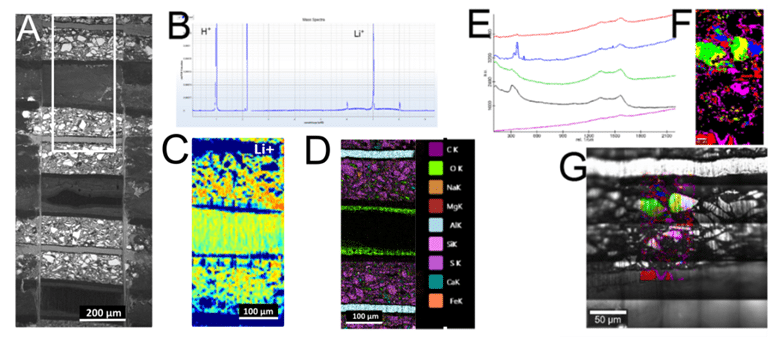Lithium ion batteries are a leading energy storage technology for electronic portable devices and hybrid electric vehicles. Simultaneous characterization of the structure, chemical composition and elemental distribution in Li-ion battery materials is an important step for understanding the relationship between transport of Li ion and structural effects on the one hand, and battery performance and its degradation on the other, as shown in [1].
We show here a multi-modal chemical analysis of Li-Ion batteries using a triplet of analytical beams combined within one device. A focused ion beam from a Xenon plasma source (P-FIB) was used for the preparation of fresh cross sections [2] and their immediate analysis using the integrated Time of Flight Secondary Ion Mass Spectroscopy (TOF-SIMS). The focused electron beam of a Scanning Electron Microscope (SEM) was used for imaging using various electron signals (SE, BSE) as well as energy dispersive x-ray microanalysis (EDX). In addition, the focused laser beam of a Confocal Raman microscope (CRM) was applied for high resolution Raman analysis. A Raman Integrated Scanning Electron (RISE) microscope [3] supplemented with TOF-SIMS in a single vacuum chamber is highly advantageous as chemical state mapping can be performed without exposing the highly reactive compounds of the Li-ion battery to an oxidizing atmosphere.

Figure 1- SEM Image of a cross section of a Li-ion battery made by plasma FIB, back-scattered electron signal (A). TOF-SIMS analysis –collected spectra (B) and a map of Li+ ion distribution within the cross section (C). EDX analysis of the same area showing element distribution (D). Micro Raman imaging of a smaller area – spectra of different phases (E), distribution of these phases (F), overlay with white-light image from CRM (G).
[1] T. Sui et. al, 2015, Nano Energy 17
[2] T. Hrnčíř et al.:2012, ISTFA Conference Proceedings, pp. 26
[3] J. Jiruše, et al.: 2014, EIPBN Conference Proceedings

